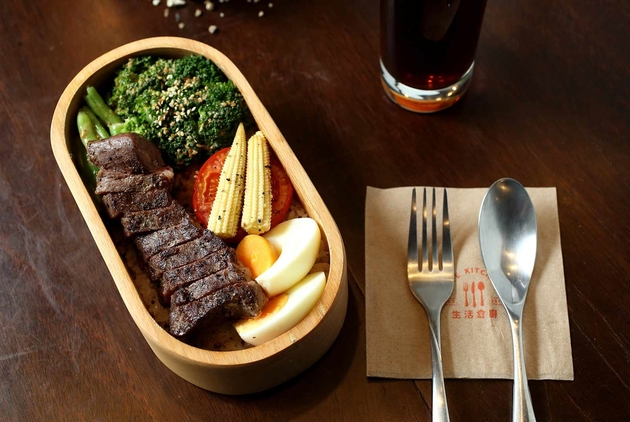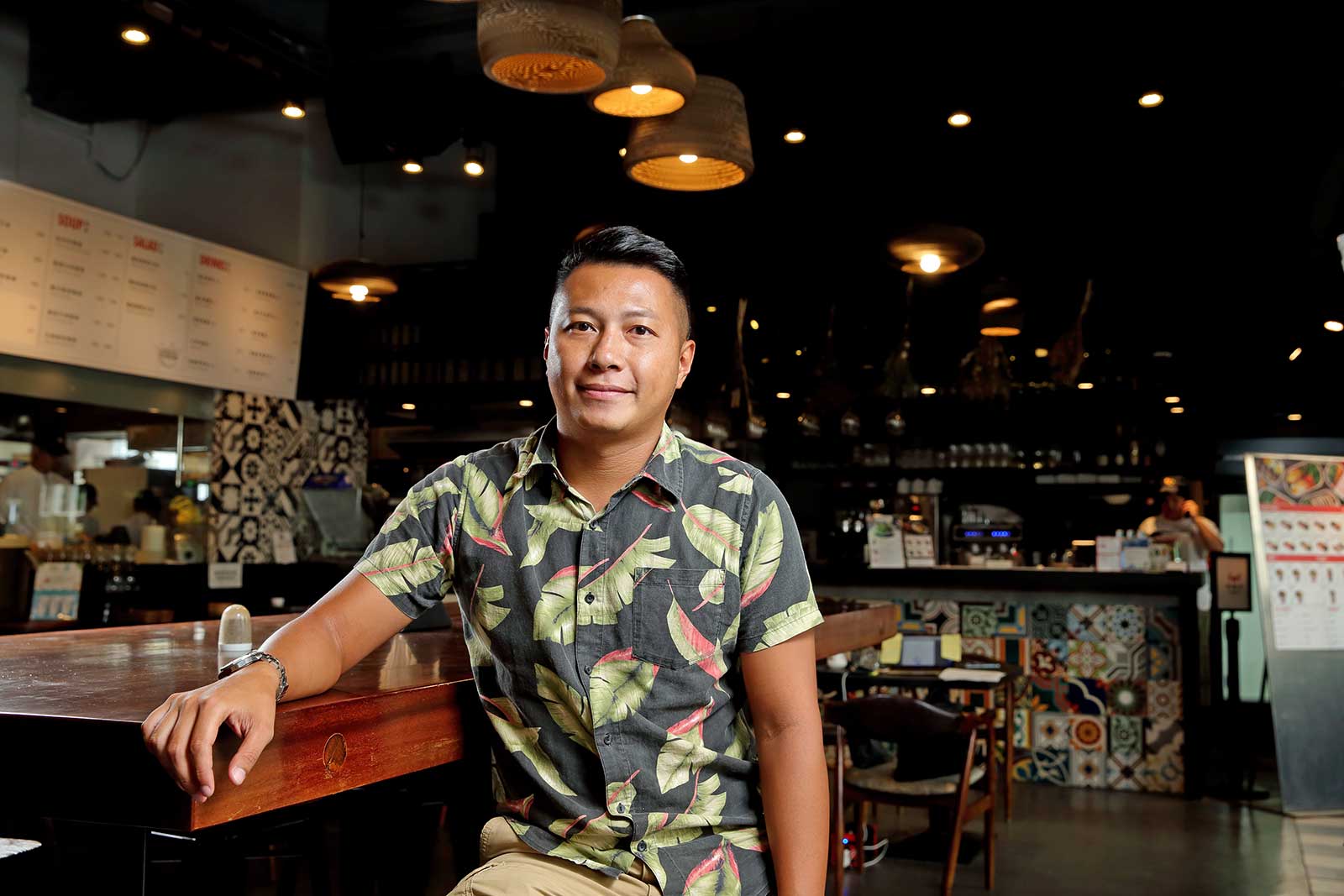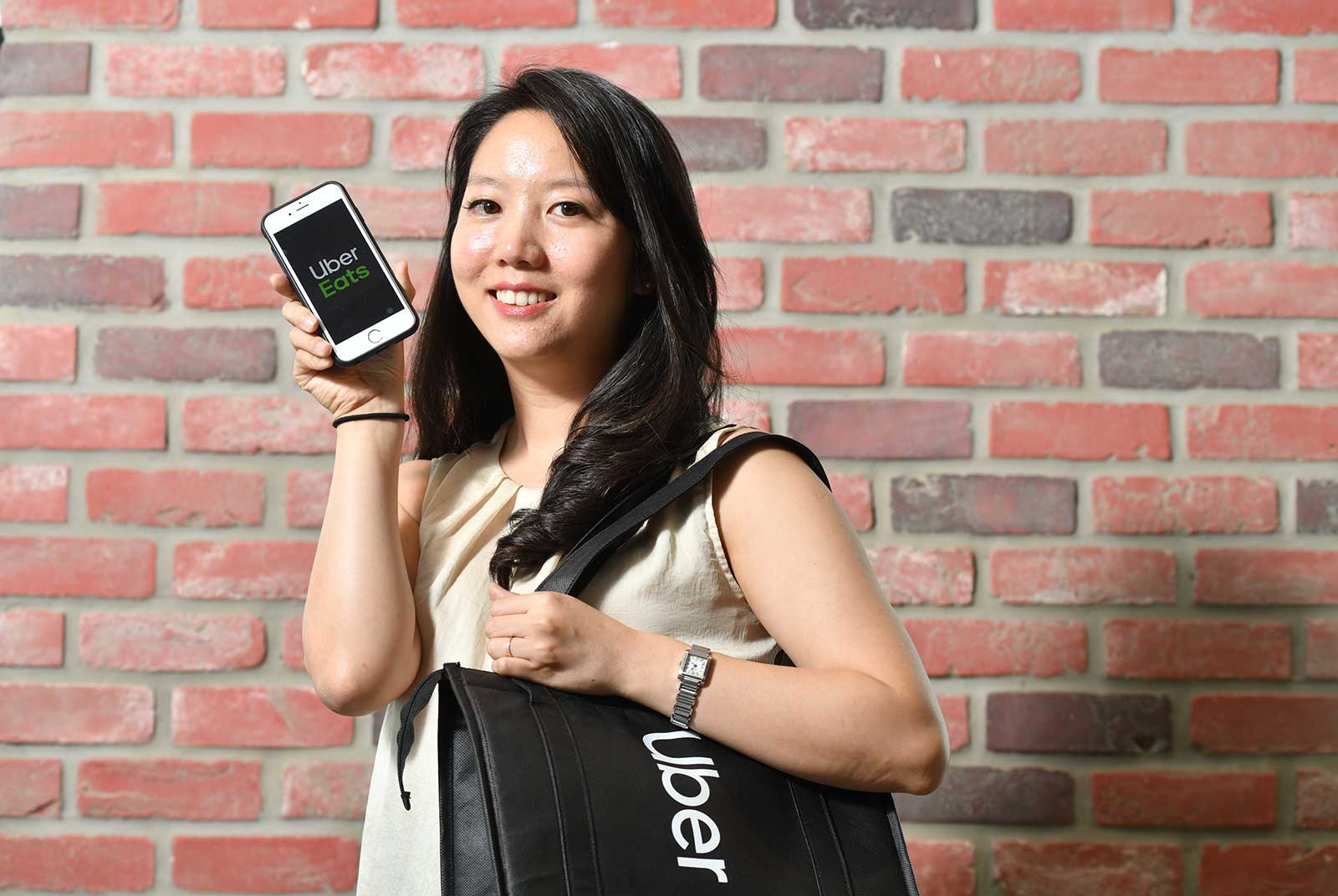Delivery Platform Wave Props up Hot New Little Restaurant Entrepreneurial Sector
The Secret to Selling 15,000 Healthy Boxed Meals

Source:Chien-Tong Wang
The last year has seen an explosion of food delivery platforms in Taiwan. Uber Eats and FoodPanda’s business is expected to triple, and “ghost kitchens” and “virtual restaurants” with no seating and no signage are riding high exclusively through delivery services. How will this hot new business model sweeping across Europe and America change the face of Taiwan’s food and beverage market?
Views
The Secret to Selling 15,000 Healthy Boxed Meals
By Chi-mei TsaiFrom CommonWealth Magazine (vol. 680 )
A 10-minute drive from the Red House in bustling Ximending, tourists rarely venture to the old Wanhua community. Hidden away there, a bento (boxed lunch) shop that has been open for just two years represents a new trend that endeavors to turn Taiwan’s food and beverage industry upside-down.
Life Kitchen, usually shuttered tight, does not look like a wildly popular shop on Uber Eats, or even a typical restaurant.
Even the security guard at the urban renewal site next door is confused, telling CommonWealth that it is a “studio space” that does not sell food. But curiously, “a bunch of delivery scooters are parked outside every day.”
By midday, this “studio” is on full alert. iPads issued by contracted delivery platforms beep constantly as orders swarm in.
The staff member receiving the orders must rapidly judge when to dispatch each order. “Five, 10, 20 minutes? What if the customer cancels the order?” Pressing the ENTER key, then manually entering it into the shop’s own POS (point-of-sale) system, the kitchen is notified and immediately begins preparing the order.
Scooping rice, ladling veggies, and cooking all meat items to order, the basic chicken boxed meal is ready in five to eight minutes. But items like thick beef steaks, rack of lamb, or a whole lobster require a full 15 minutes crackling on the grill.
Finally the cooked meat is placed on top of the box, the lid is closed, and it is put in a bag. Without a hitch, delivery staff stand ready at their scooters to load orders.
70% of Deluxe Healthy Boxed Meal Business From Delivery Platforms
Life Kitchen’s main focus is on Western-style “healthy bento” (note: bento is Japanese for “boxed meal”), to reshape people’s associations of bento with oily food that just staves off hunger.

Chang Sheng-wei, executive director of Nenghuo International and founder of Life Kitchen, credits his inspiration to the “naked food” concept popular abroad. This involves selling “food in its original state,” not overly processed “food products.” Consequently, the boiled broccoli, lamb chop breast, and salmon fillet are all served in generous portions - large chunks of “unadorned” meat.
To see what all the fuss was about, we ordered a lamb chop breast quinoa bento for NT$499. As soon as we opened the lid we were shocked by the substantial portion of the main course, which was comparable to most Western-style restaurants.
Surely the number of calories in that portion were off the charts!
A former swimming coach, Chang Sheng-wei flatly states, “Our appeal is to health and nutrition, not weight loss.”
A boxed meal and salad, costing between NT$260 and NT$600, is enough to make an average adult feel mostly full. And they are selling like crazy.
Chang opened four direct-to-consumer shops within two years, selling a combined 500 boxed meals per day, or upwards of 15,000 a month. Over 70 percent of the sales can be attributed to the Uber Eats delivery platform.

Former swimming coach Chang Sheng-wei, founder of Life Kitchen, relates that Life Kitchen seeks to promote health and nutrition along the lines of the “naked food” concept popular in the West, selling “real food.” Each boxed meal features a generous main dish - a large helping of “real food.” (Photo by Chien-Tong Wang/CW)
“Life Kitchen is the first to make healthy bento boxes, and was subsequently followed by a bunch of others appearing to copy them. The demand for this type of food has dramatically risen on our platform,” says Chai Lee, general manager of Uber Eats for Taiwan.
Chang has many years of kitchen experience in fine restaurants. A little over two years ago, he was approached by a friend working in general goods e-commerce to work together to develop a fresh meat and produce delivery business.
The pair purchased numerous refrigerators and freezers and bought up vast quantities of high-end meat products, which they then sliced and vacuum packed. Based in a beautifully appointed basement kitchen with a central island, they planned to sell meat directly.
At first, his friend was bursting with confidence, exclaiming, “We can sell anything.” But with business being terrible following a trial period, the two came to the alarming realization that general e-commerce customers tend to be young, tech-savvy consumers, most of whom do not cook or even have a kitchen space in the place they rent (Read: What’s the Scoop on “Brick and Mortar E-commerce?”). “Even if you give the customer a piece of meat, they have no idea what to do with it.”
What to do with all the frozen meat? Racking his brains, Chang was struck by inspiration, coming up with the idea of making hot boxed meals with top grade meat, offering it on a trial basis to friends and businesses in return for first-hand feedback.
Uber Eats was just arriving in Taiwan at the time, and not yet having secured a shop space, Chang approached them about working together. Having failed at selling meat online, he would switch to selling prepared boxed meals.
“At first we were afraid that we’d go out of business, and I stayed glued to the kitchen for months on end, scared to take any time away. We went through a lot of struggle and hardship over that period,” relates Chang. Having endured their first extended Chinese New Year holiday break, fortune finally arrived on a delivery scooter.
The Wanhua showroom became Life Kitchen’s living room, without a dining area, and with all delivery and takeout orders handled online. Effective delivery platform advertisements helped accelerate the flow of inventory through the fridges and reduce waste, while helping to better gauge ingredient demand.
Have you read?
♦ How Bubble Tea Conquered the Taste Buds of The Japanese
♦ Behind Taiwan's Vegetarian Night Market Phenomenon
♦ Save Food to Stop Wastage
Intense Competition among Delivery Platforms as Demand Explodes
The past year has seen an explosion of delivery platforms in Taiwan.
“The growth of delivery platforms has been scary...really scary. It’s seriously scary, and even a little out of balance, like nobody wants to leave the house. Do you feel the same way?” asks Chang, a major beneficiary of this trend, who nonetheless describes his feelings by repeating the word “scary” three times.
“Delivery via apps has been going on in Taiwan for quite a few years, until this year it finally exploded. Consumer habits having been cultivated, the delivery app market truly opened up,” says Chai Lee. And as more and more people hang out at home, meal orders even reach peaks on weekend nights.
Taiwan has become one of Uber Eats’ fastest-growing markets in Asia, expanding services to cover eight major cities along the western corridor. The number of restaurants listed on the platform has doubled compared to the same period last year, now standing at 6,000, and the number of active users and deliveries have both tripled.

Chai Lee, general manager of Uber Eats for Taiwan, relates that deliveries via app have been around in Taiwan for many years, but finally exploded this year. As more and more people opt to hang out at home, meal orders even peak on weekend nights. (Photo by Kuo-Tai Liu/CW)
Market leader FoodPanda, a German company that was one of the earliest to establish itself in Taiwan, saw the number of restaurants it partners with exceed 7,000 this year, with orders expected to triple compared to last year.
Late last year, Deliveroo, a company started by Will Hsu of the UK, found its sweet spot in Taiwan, investing heavily in marketing and subsidizing users.
Under the intense competition, Singapore-based Honestbee withdrew from the market in July, and local platform Chibao Mei, once ranked third in all of Taiwan, announced on its website on August 15 that it was shuttering its business and laying off more than 20 employees.
New entrants come on strong, and existing businesses boost marketing, as all sides clash vying to align with high profile shops and recruit delivery staff. Together, they compete for piece of a food delivery market worth NT$23.6 billion annually (as of 2018), or around five percent of the total food and beverage industry production value.
Ultra High Efficiency New Channels Engendering New Species of Restaurants
Prior to the emergence of delivery apps, the food and beverage industry lacked data and transparency. This was especially true of small- and medium-sized local restaurants, who were largely guided by the boss’s experience.
“Delivery services can increase restaurant orders, and by taking orders in advance can also even out some of the peak and off-peak production capacity,” relates Li Shyh-Jane, deputy director of the Business Model Innovation Research Division at the Commerce Development Research Institute.
Li notes that, buoyed by the home delivery trend, platforms with a good grasp of Big Data can further provide market analysis services to help reduce restaurants’ investment risks. This has overturned the conventional restaurant model under which everything transpires offline, giving rise to expansive room for imagination.
“It’s like the second floor effect, where a restaurant with no seating engages purely in takeout and delivery,” Li says. “So as long as they concentrate on the quality of their menu offerings, there is a certain clientele (ready to take advantage of their services).”
This type of restaurant, like Life Kitchen, can be described with a name that sounds like the title of a Hollywood horror film: “ghost kitchen.”
Type 1: Ghost Kitchens Offering Takeout and Delivery Only
For example, Geliou’s GRILLED SeNDWIsH shop is situated in the commercial warzone of Taipei’s East District, surrounded by numerous office buildings.
Two years ago, Geliou’s eliminated its cramped dining space completely in favor of an exclusive takeaway and delivery model. “Having the delivery app is like another franchise, where consumers can surf and select what they want to eat. This allows us to choose a location in an alleyway with cheaper rent while engaging in the same kind of business,” relates proprietor Wang Hai-jung.
Geliou’s shop is open six days a week, going full bore from start time through 2-3:00 p.m. Delivery orders hover around 300 per week, accounting for a full 80 percent of overall business.
Wang Hai-jung has honed a keen sensitivity to data thanks to the platform. Before rolling out a new salad offering this summer, Wang checked with his Uber Eats liaison to go over the price range and demand for salad dishes. “In the future, I suggest that restaurants in urban areas consider delivery services when designing their menu, as the related overall marketing and operational models are completely different.”
Type 2: Online to Offline
While Wanhua’s The Living Room made a name for itself online, Life Kitchen took the opposite approach, going from online to offline with a succession of brick-and-mortar outlets featuring slick modern appointments.
“We’re the first restaurant in Taiwan to start online and turn our business into physical restaurants,” boasts Chang.
 Having established a reputation online, Life Kitchen proceeded to open four physical restaurants in Neihu, Da’An, Nangang, and the Hsinchu Science Park. (Photo by Chien-Tong Wang/CW)
Having established a reputation online, Life Kitchen proceeded to open four physical restaurants in Neihu, Da’An, Nangang, and the Hsinchu Science Park. (Photo by Chien-Tong Wang/CW)
The Neihu outlet is close to the Costco shopping area, some distance away from the major commercial zone of the Neihu High Tech Science Park stretching along Gangqian and Ruiguang roads. Despite having a seating capacity of 70, delivery services still make up the majority of its business. Each boxed meal takes about five to eight minutes to prepare, meeting the demand from workers in the Neihu Science Park.
“The people on the delivery platforms are the type that are willing to enjoy life; everyone’s too lazy; they want the little pleasures in life, and to eat well if they have money. Those that don’t have money are the ones that keep riding around on scooters delivering food. Then there are the indiscriminate consumers, who link their credit cards to platform consumption, settle up every month, and never have to dig for change.” After selling boxed meals online for two years, Chang observes that workers in large corporations, solo entrepreneurs, and rich foodie housewives comprise the core target audience for healthy boxed meals.
Chang relates that these people are a dime a dozen on delivery platforms, owing largely to their approach to life and the wealth gap. However, in spite of establishing a customer base, the approximately 30 percent taken out of sales by delivery platforms is not an insignificant cost, so in order to broaden the brand’s scope, it is necessary to actively go after the offline sector.
Type 3: Birth of the Virtual Restaurant; One Kitchen, Two Stores
Virtual restaurants are another new type of business currently gaining popularity in the United States.
According to the New York Times, Uber Eats and partner restaurants have opened 4,000 “virtual restaurants” between 2017 and the present.
Working together with Uber Eats and Deliveroo, Sanukinoya, a Japanese restaurant, derives about 30 percent of its business from deliveries. Last year, it opened up a virtual restaurant in Taipei.
During last year’s football World Cup, Uber Eats discovered through Big Data that users searched heavily for Korean cuisine in the vicinity of Sanukinoya’s Jinzhou Road branch. However, as there were few restaurants in the area capable of stepping up to meet that need, alternative searches ended up dying on the vine.
At Uber Eats’ recommendation, Sanukinoya proprietor Lin Yi-yung formulated around half a dozen Korean dishes, and using the same kitchen launched a virtual Korean smokehouse, becoming one of around a dozen pop-up restaurants that emerged on Uber Eats during the World Cup.
The restaurant, which existed only on the Uber Eats app, helped Sanukinoya’s orders grow 109 percent in its first month.
“For the kitchen, it was an additional offering, but the effect wore off, maybe because consumers couldn’t find a physical restaurant or were not entirely comfortable,” surmises Lin. Late last year when the Jinzhou outlet ceased operations, the lights of the mysterious Korean smokehouse also went out.
“Most e-commerce restaurants with an online presence aren’t willing to give up foot traffic customers. Even though (online) platforms can help direct customer traffic and build awareness, they also take a big cut,” says Li Shyh-Jane.
Delivery Platform Wave Props up Hot New Little Restaurant Entrepreneurial Sector
Just as Uber lowered the threshold for car rentals, and Airbnb lowered the threshold for lodging, the rise of food delivery platforms similarly lowered the threshold in its field, allowing small-scale restaurants with unique menus that were previously unable to afford to pay delivery staff to expand their sphere of influence several-fold in one fell swoop.
Thus a new type of “ghost restaurant” has become the most popular new entrepreneurial field in Europe and America.
After his dismissal in 2017 from the board of Uber, the company he founded, Travis Kalanick turned around and founded CloudKitchens. The company’s main concept can be described as “shared ghost kitchens,” letting proprietors rapidly expand to new locations to run delivery businesses by renting “smart” kitchens.
Uber Eats and Deliveroo are both expanding, testing their own variations of the “shared ghost kitchen” concept.
A new battle for survival of the fittest is rapidly heading towards Taiwan from the Western world.
Taiwanese love to eat and really know their food, giving rise to a diverse and flourishing food and beverage market. Now, with the entry of delivery platforms, a new retail war is heating up on all fronts of the food and beverage sector.
Businesses that are unable to keep up with the new ground rules, should they take their eye off the ball, could find themselves out of the game in a hurry.
Translated by David Toman
Edited by TC Lin, Sharon Tseng











